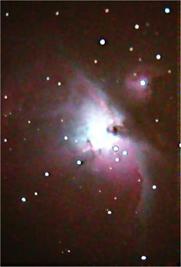LCAS Observer Challenge - February 2005
Dave Wagner
It's extra cold tonight as I step up to my front door. It's a clear night, and clear skies allow what little heat there is in the air to radiate up from the ground, rapidly dropping the already frigid temps. But before I escape to warmth of my abode, while I still have a remnant of that car heat in my shoes, I can turn and look directly south and enjoy a very special constellation. The brightness of the snow on the ground, even the glowing moon can't erase the magnitude and clarity of the constellation of ORION, host of 9 wonderful Observer Challenge items.
Jan / Feb ORION OC Sights M42, M43, M78, NGC1975/1977, NGC1981, NGC2024, IC434/B33
Orion is the brightest and perhaps arguably one of the best constellations of our night sky. It has 9 stars of 3rd magnitude or brighter, 5 of these stars are first magnitude, two (Rigel and Betelgeuse) are zero magnitude. Even under light polluted skies, the stars call out a massive, but recognizable giant figure in our night sky, standing watch with his shield and club. And Orion is so much more! It has 6 galactic star clusters, twenty plus nebulae, and hundreds of viewable double and multiple stars.
The Great Orion Nebula
Perhaps the most famous of the nebulae is the "Great Orion Nebula", or M42. Visible to the naked eye, glowing from the stars forming within, it is a great sight with binoculars, and an awesome telescope object. At about 1,300 light years from us, the very dense star-forming region of the nebula that we typically observe is about 5 light years across. In reality (and needing the assistance of photography to visualize) the nebula extends for a span of 32 light years, extending some 66x60 arc minutes, thus covering four times the area of the full Moon.

M42 - photo courtesy Jack Kramer
So What Color Is It?
The nebula is nearly completely comprised of hydrogen and helium, but due to a small percentage of oxygen in the nebula we visually observe it as having a green color. When viewing photos, you will more likely see a deep red color, which is associated with the more abundant and camera sensitive hydrogen atoms in the nebula.
The Big Challenge
The "Horsehead Nebula", IC 434/B33, is as famous as it is difficult to observe. Consisting of a background glow of IC434, and the dark dust cloud of B33, it forms an artful form of a horse's head. As with other large low contrast objects, you'll need LOW power, wide FOV, dark skies and good dark adaptation to eyeball the Horsehead. Wide aperture binoculars can do the trick as well.
More on Orion ![]()
Binoculars: http://www.dibonsmith.com/ori.htm





